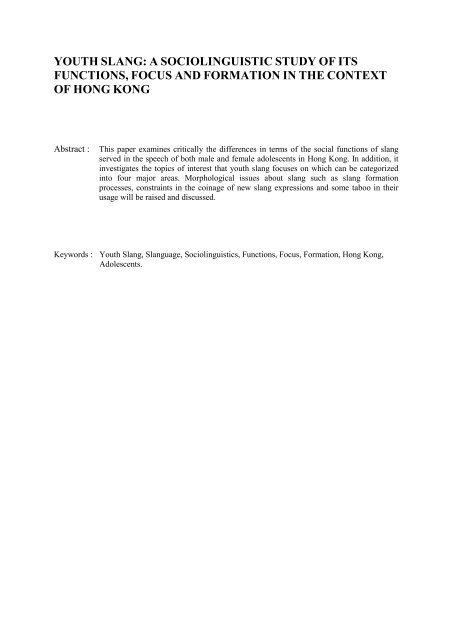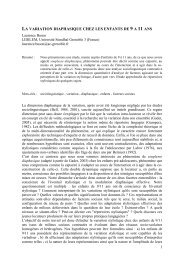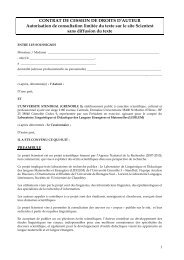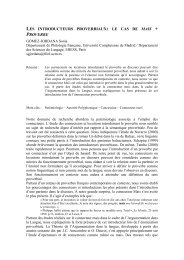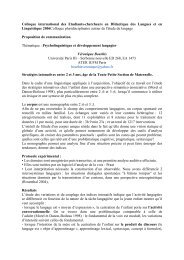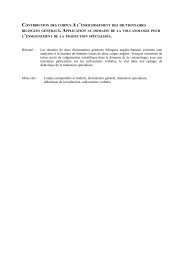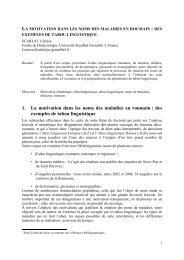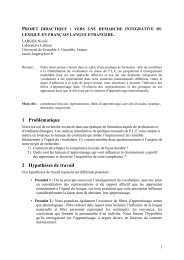YOUTH SLANG: A SOCIOLINGUISTIC STUDY OF ITS FUNCTIONS ...
YOUTH SLANG: A SOCIOLINGUISTIC STUDY OF ITS FUNCTIONS ...
YOUTH SLANG: A SOCIOLINGUISTIC STUDY OF ITS FUNCTIONS ...
Create successful ePaper yourself
Turn your PDF publications into a flip-book with our unique Google optimized e-Paper software.
<strong>YOUTH</strong> <strong>SLANG</strong>: A <strong>SOCIOLINGUISTIC</strong> <strong>STUDY</strong> <strong>OF</strong> <strong>ITS</strong><br />
<strong>FUNCTIONS</strong>, FOCUS AND FORMATION IN THE CONTEXT<br />
<strong>OF</strong> HONG KONG<br />
Abstract :<br />
This paper examines critically the differences in terms of the social functions of slang<br />
served in the speech of both male and female adolescents in Hong Kong. In addition, it<br />
investigates the topics of interest that youth slang focuses on which can be categorized<br />
into four major areas. Morphological issues about slang such as slang formation<br />
processes, constraints in the coinage of new slang expressions and some taboo in their<br />
usage will be raised and discussed.<br />
Keywords : Youth Slang, Slanguage, Sociolinguistics, Functions, Focus, Formation, Hong Kong,<br />
Adolescents.
Youth Slang: A Sociolinguistic Study of its Functions, Focus and<br />
Formation in the context of Hong Kong<br />
Slang is traditionally considered as a vulgar, offensive, and profane form of language with a<br />
strong color of irreverence and yet vitality in a society. It is generally labeled as a linguistic<br />
taboo which should not be appearing in most formal social occasions. Since it is “customarily<br />
reported as the idiosyncratic and deviant vocabulary of quirky or suspicious groups” (Eble,<br />
1998: 42), slang has always been neglected, if not ignored, in sociolinguistics. Therefore,<br />
formal and theoretical discussions of slang in sociolinguistic perspectives are largely absent.<br />
Very often, lexicographical documentation, semantic classification, and etymological<br />
description of slang items are the primary, if not the only, focus in traditional studies of slang<br />
(Drake, 1979, Szabó, 1998, Androutsopoulos, 1999).<br />
Contrary to the situation in the US and many European countries where research and projects<br />
on slang such as The UCLA Slang Project (Munro, 1989, 1993, 1997) are popular and studies<br />
of slang are even incorporated as a component of the educational curriculum (Eble, 1989,<br />
Munro, 1989, Adams, 2002), Asian societies like Hong Kong are largely devoid of systematic<br />
records and critical analysis of the phenomenon of slang, especially the Cantonese slang<br />
(Hutton and Bolton, 2005) which can be attributable to the cultural and linguistic<br />
conservatism in the academic atmosphere in comparing to the Western societies. Bolton and<br />
Hutton (1997: 300) remarked that “what seems to distinguish the situation in Hong Kong from<br />
the situation in Western Societies is that there is much less official tolerance of bad language<br />
[slang] in the territory than is the case, for example, in Britain”.<br />
This paper examines critically the differences in terms of the social functions of slang served<br />
in the speech of both male and female adolescents in Hong Kong. It was found out that male<br />
and female adolescents are under very different motives to use slang, and it is nearly<br />
impossible to make judgment on the sexes of the speakers simply from the slanguage s/he<br />
uses. In addition, it investigates the topics of interest that youth slang focuses on. It was found<br />
out that youth slang in Hong Kong mainly centers on four primary topics which are 1.<br />
- 2 -
Evaluations (usually negative) of people, things or events; 2. Appearance and style; 3. Sex<br />
(including sex organs, activities, dating, etc.); and 4. Leisure and fun. Focus will be<br />
particularly on the third category, sex, since such area is always under the youth’s interest<br />
across different cultures and societies. A prominent example is 食 蟻 獸 sik6 ngai5 sau3 1 “anteater”<br />
(ant-eater). The long and tube-like head of an ant-eater is metaphorically compared to a<br />
long, rough and thick uncircumcised penis. Male adolescents found such label extremely<br />
repugnant and insulting. The major reason is due to the implications about the<br />
malfunctionality of the penis and disagreeable experience during sexual intercourse embedded<br />
in this term. Morphological issues about slang such as slang formation processes will also be<br />
covered. Constraints in the coinage of new slang expressions and some taboo in their usage<br />
will be raised and discussed.<br />
As for the methodology of this slanguage study, it covered both quantitative and qualitative<br />
approaches. In this study, data were collected through three major sources i.e. questionnaire<br />
survey, face-to-face interviews (both group and individual ones), and direct observations.<br />
Additional written data were collected through youth magazines and related materials;<br />
teenage chat rooms, newsgroups, and Bulletin Board System (BBS); movies; lyrics of popular<br />
songs; sport and cultural centers; game centers and Internet café bars; etc. These research<br />
methods and the written data are complementary to one another. A balanced and strategic<br />
employment of these research methods is expected to generate findings with high reliability<br />
and validity.<br />
1 The italicized parts represent Cantonese romanizations which are based on the Cantonese Romanization<br />
Scheme developed by the Linguistic Society of Hong Kong (LSHK). URL:<br />
http://cpct92.cityu.edu.hk/lshk/Jyutping/Jyutping.htm<br />
- 3 -
References<br />
ADAMS, M. (2002). Teaching “bad” American English. Journal of English Linguistics, 30, 4,<br />
353-365.<br />
ANDROUTSOPOULOS, J.K. (1999). Extending the concept of the (socio)linguistic variable<br />
to slang. In K. TAMÁS (Ed.), Mi a szleng (pp. 109-140). Debrecen: Kossuth Lajos<br />
University Press.<br />
BOLTON, K. and C. HUTTON. (1997). Bad boys and bad language: chou hau and the<br />
sociolinguistics of swearwords in Hong Kong Cantonese. In G. EVANS and M. TAM<br />
(Eds.), Hong Kong: The Anthropology of a Chinese Metropolis (pp. 299-335).<br />
Richmond, Surrey: Curzon Press.<br />
DRAKE, G.F. (1979). The social role of slang. In H. GILES and W.P. ROBINSON (Eds.),<br />
Language: Social Psychological Perspectives: Selected Papers from the First<br />
International Conference on Social Psychology and Language (pp. 63-70). Oxford:<br />
Pergamon Press.<br />
EBLE, C. (1998). Youth slang studies in the USA. In J.K. ANDROUTSOPOULOS & A.<br />
SCHOLZ (Eds.), Jugendsprache−Langue Des Jeunes−Youth Language.<br />
Soziolinguistische Und Linguistische Perspektiven. (pp. 35-48). Frankfurt a. M.: Peter<br />
Lang.<br />
HUTTON, C. and K. BOLTON. (2005). A Dictionary Of Cantonese Slang: The Language Of<br />
Hong Kong Movies, Street Gangs And City Life. London: C. Hurst & Co.<br />
MUNRO, P. (1989). Slang U. New York: Harmony Books.<br />
MUNRO, P. (1993). U.C.L.A. Slang 2. Los Angeles, Calif.: Dept. of Linguistics, University<br />
of California, Los Angeles.<br />
MUNRO, P. (1997). U.C.L.A. Slang 3. Los Angeles, Calif.: Dept. of Linguistics, University<br />
of California, Los Angeles.<br />
SZABÓ, D. (1998). Methodological problems of the sociolinguistic study of youth slang:<br />
Paris teenagers' argot commun. In J.K. ANDROUTSOPOULOS & A. SCHOLZ<br />
(Eds.), Jugendsprache−Langue Des Jeunes−Youth Language. Soziolinguistische Und<br />
Linguistische Perspektiven. (pp. 49-58). Frankfurt a.M.: Peter Lang.<br />
- 4 -


